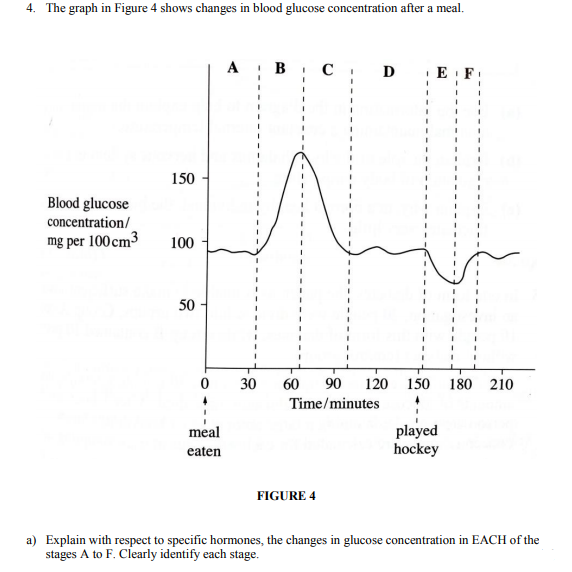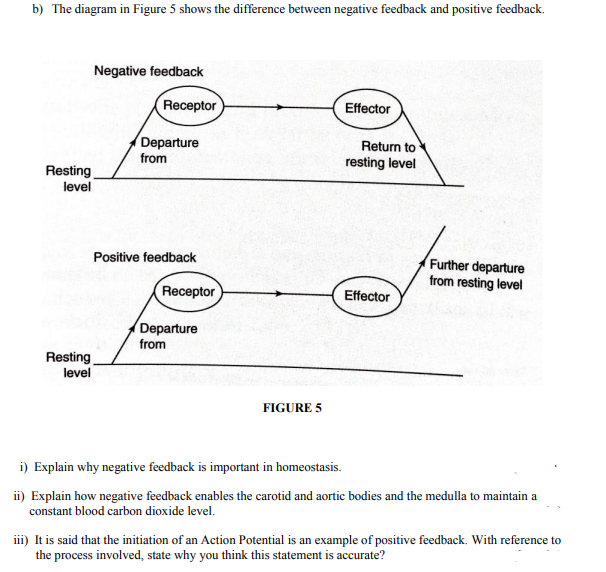Biology: The Dynamic Science (MindTap Course List)
4th Edition
ISBN:9781305389892
Author:Peter J. Russell, Paul E. Hertz, Beverly McMillan
Publisher:Peter J. Russell, Paul E. Hertz, Beverly McMillan
Chapter42: The Endocrine System
Section: Chapter Questions
Problem 8TYK
Related questions
Question

Transcribed Image Text:4. The graph in Figure 4 shows changes in blood glucose concentration after a meal.
A
B
D
E F.
150
Blood glucose
concentration/
mg per 100 cm3
100
50
30
60
90
120 150 180 210
Time/minutes
played
hockey
meal
eaten
FIGURE 4
a) Explain with respect to specific hormones, the changes in glucose concentration in EACH of the
stages A to F. Clearly identify each stage.

Transcribed Image Text:b) The diagram in Figure 5 shows the difference between negative feedback and positive feedback.
Negative feedback
Receptor
Effector
Departure
Return to
resting level
from
Resting
level
Positive feedback
Further departure
from resting level
Receptor
Effector
Departure
from
Resting
level
FIGURE 5
i) Explain why negative feedback is important in homeostasis.
ii) Explain how negative feedback enables the carotid and aortic bodies and the medulla to maintain a
constant blood carbon dioxide level.
iii) It is said that the initiation of an Action Potential is an example of positive feedback. With reference to
the process involved, state why you think this statement is accurate?
Expert Solution
This question has been solved!
Explore an expertly crafted, step-by-step solution for a thorough understanding of key concepts.
Step by step
Solved in 3 steps

Knowledge Booster
Learn more about
Need a deep-dive on the concept behind this application? Look no further. Learn more about this topic, biology and related others by exploring similar questions and additional content below.Recommended textbooks for you

Biology: The Dynamic Science (MindTap Course List)
Biology
ISBN:
9781305389892
Author:
Peter J. Russell, Paul E. Hertz, Beverly McMillan
Publisher:
Cengage Learning

Biology: The Unity and Diversity of Life (MindTap…
Biology
ISBN:
9781337408332
Author:
Cecie Starr, Ralph Taggart, Christine Evers, Lisa Starr
Publisher:
Cengage Learning

Anatomy & Physiology
Biology
ISBN:
9781938168130
Author:
Kelly A. Young, James A. Wise, Peter DeSaix, Dean H. Kruse, Brandon Poe, Eddie Johnson, Jody E. Johnson, Oksana Korol, J. Gordon Betts, Mark Womble
Publisher:
OpenStax College

Biology: The Dynamic Science (MindTap Course List)
Biology
ISBN:
9781305389892
Author:
Peter J. Russell, Paul E. Hertz, Beverly McMillan
Publisher:
Cengage Learning

Biology: The Unity and Diversity of Life (MindTap…
Biology
ISBN:
9781337408332
Author:
Cecie Starr, Ralph Taggart, Christine Evers, Lisa Starr
Publisher:
Cengage Learning

Anatomy & Physiology
Biology
ISBN:
9781938168130
Author:
Kelly A. Young, James A. Wise, Peter DeSaix, Dean H. Kruse, Brandon Poe, Eddie Johnson, Jody E. Johnson, Oksana Korol, J. Gordon Betts, Mark Womble
Publisher:
OpenStax College



Biology: The Unity and Diversity of Life (MindTap…
Biology
ISBN:
9781305073951
Author:
Cecie Starr, Ralph Taggart, Christine Evers, Lisa Starr
Publisher:
Cengage Learning